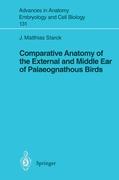Comparative Anatomy of the External and Middle Ear of Palaeognathous Birds
BücherAngebote / Angebote:
1. 1 Objectives of this Study The vertebrate middle ear has attracted the interest of morphologists for more than a century. Its difficult structure, its complicated evolutionary derivation, and its integration of branchial, cranial, and otic materials into a single func tional unit have made it a key organ for the understanding of vertebrate structures and their evolutionary history. Gaupp's (1898, 1913) and Reichert's (1837) comparative morphological studies of the vertebrate middle ear repre sented milestones for anatomy in the general recognition and acceptance of Darwin's theory of evolution. These fundamental studies notwithstanding, today's knowledge of avian middle ear structures is still characterized by descriptive studies focusing on character sampling to elucidate high-level phylogeny. Phylogenetic studies have considered either structural aspects of the bony stapes exclusively (Feduccia 1974, 1975a, b, 1976, 1977, 1978), or focused on the anatomy of the middle ear cavity, neglecting the sound trans mission apparatus (Saiff 1974, 1976, 1978a, b, 1981, 1982, 1983, 1988). Other studies have investigated late-stage embryos and concentrated on the develop ment of the skull, considering middle ear structures only as a side aspect. However, there are considerable structural differences between the middle ears of late-stage embryos, hatchlings, and adults of the same species. Although vertebrate morphology requires a meticulous knowledge of comparative middle ear data and calls upon an elaborate system of homologies, it turns out that knowledge of middle ear structural details is widely dispersed among different species and different developmental stages, making a comparison even more difficult.
Folgt in ca. 5 Arbeitstagen




